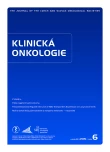Possible Pitfalls of Ipilimumab Therapy in Malignant Melanoma – a Case Report
Authors:
J. Kopecký 1; O. Kubeček 1; F. Gabalec 2; P. Hoffmann 3; I. Svilias 2
Authors‘ workplace:
Klinika onkologie a radioterapie LF UK a FN Hradec Králové
1; Endokrinologie, IV. interní hematologická klinika LF UK a FN Hradec Králové
2; Radiologická klinika LF UK a FN Hradec Králové
3
Published in:
Klin Onkol 2015; 28(6): 444-449
Category:
Case Reports
doi:
https://doi.org/10.14735/amko2015444
Overview
Background:
Metastatic melanoma is a malignancy with one of the highest mortality rates. However, with the introduction of new drugs during the last decade, the prognosis of patients began to improve. Ipilimumab is one of the first so ‑ called modern drugs in melanoma treatment. The therapy is often complicated by adverse effects which are referred as immune‑related adverse events due to its mechanism of action.
Case:
We present a case of 68‑year ‑ old women with metastatic melanoma who underwent treatment with ipilimumab. The patient encountered several adverse events during the treatment. Some of them are quite common (e.g. skin affections), others (e.g. endocrinopathies) are less frequent.
Conclusion:
This case study highlights the need for close observation not only during the actual treatment with ipilimumab, but also several weeks or months after the last dose. This case study also demonstrates further need of education of doctors who do not usually come in to contact with such patients.
Key word:
melanoma – ipilimumab – hypohysitis – CTLA-4
The work was realized with the support PRVOUK 37/06.
The authors declare they have no potential conflicts of interest concerning drugs, products, or services used in the study.
The Editorial Board declares that the manuscript met the ICMJE recommendation for biomedical papers.
Submitted:
30. 8. 2015
Accepted:
20. 9. 2015
Sources
1. Peggs KS, Quezada SA, Korman AJ et al. Principles and use of anti‑CTLA4 antibody in human cancer immunotherapy. Curr Opin Immunol 2006; 18(2): 206 – 213.
2. Hodi FS, O‘Day SJ, McDermott DF et al. Improved survival with ipilimumab in patients with metastatic melanoma. N Engl J Med 2010; 363(8): 711 – 723. doi: 10.1056/ NEJMoa1003466.
3. Robert C, Thomas L, Bondarenko I et al. Ipilimumab plus dacarbazine for previously untreated metastatic melanoma. N Engl J Med 2011; 364(26): 2517 – 2526. doi: 10.1056/ NEJMoa1104621.
4. Weber JS, Kahler KC, Hauschild A. Management of immune‑related adverse events and kinetics of response with ipilimumab. J Clin Oncol 2012; 30(21): 2691 – 2697. doi: 10.1200/ JCO.2012.41.6750.
5. Kopecký J, Kubeček O, Trojanová P et al. Nežádoucí účinky novodobé léčby maligního melanomu a jejich léčba/ management. Klin Onkol 2014; 27(6): 393 – 400. doi: 10.14735/ amko2014393.
6. Araujo PB, Coelho MC, Arruda M et al. Ipilimumab induced hypophysitis: review of the literature. J Endocrinol Invest 2015; 38(11): 1159 – 1166. doi: 10.1007/ s40618 ‑ 015 ‑ 0301 ‑ z.
7. Iwama S, De Remigis A, Callahan MK et al. Pituitary expression of CTLA ‑ 4 mediates hypophysitis secondary to administration of CTLA ‑ 4 blocking antipody. Sci Transl Med 2014; 6(230): 230 – 245. doi: 10.1126/ scitranslmed.3008002.
8. Drbalová K, Vodák M, Zamrazil V. Subklinické tyreopatie. Med Praxi 2012; 9(4):163 – 166.
9. Min L, Vaidya A, Becker C. Association of ipilimumab therapy for advanced melanoma with secondary adrenal insufficiency: a case series. Endocr Pract 2012; 18(3): 351 – 355. doi: 10.4158/ EP11273.OR.
10. Lam T, Chan MM, Sweeting AN et al. Ipilimumab induced hypophysitis in melanoma patients: an Australian case series. Intern Med J 2015; 45(10): 1066 – 1073. doi: 10.1111/ imj.12819.
Labels
Paediatric clinical oncology Surgery Clinical oncologyArticle was published in
Clinical Oncology

2015 Issue 6
Most read in this issue
- A Case of Delayed Diagnosis of Acral Lentiginous Melanoma
- Triple Negative Breast Cancer
- Immunotherapy for the Prevention and Treatment of Breast Cancer
- Psychological Aspects of Intravenous Treatment in Oncology and Permanent Venous Access Devices Tolerance
